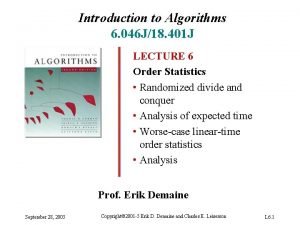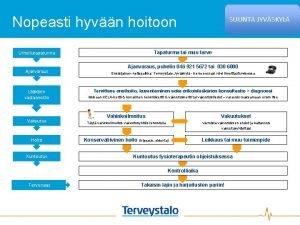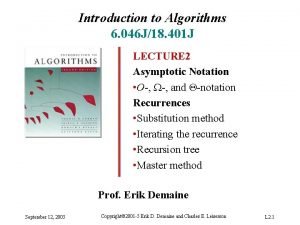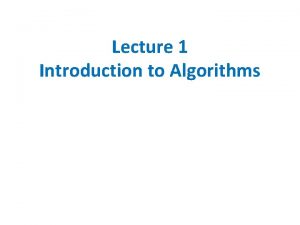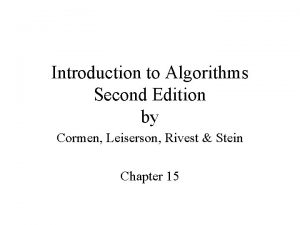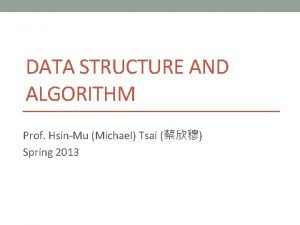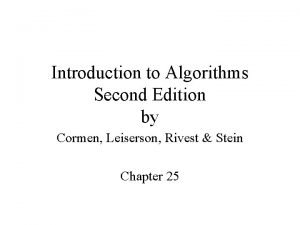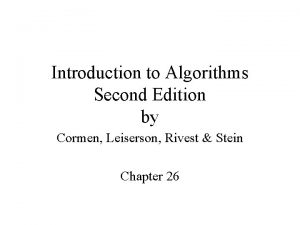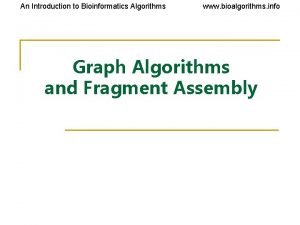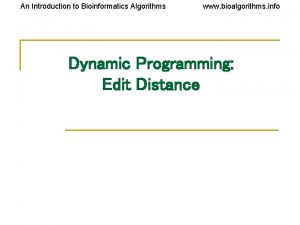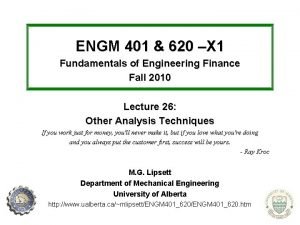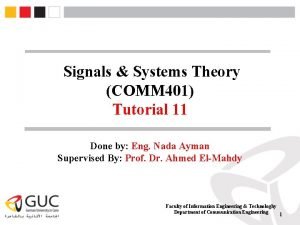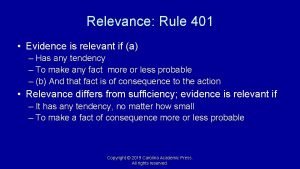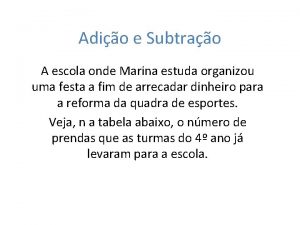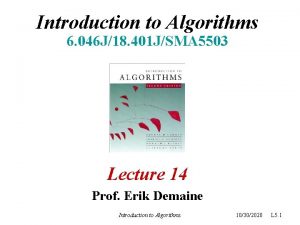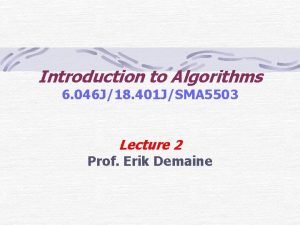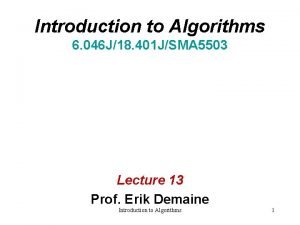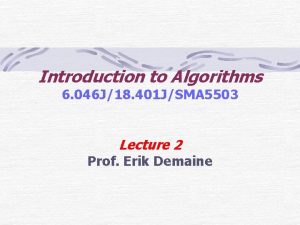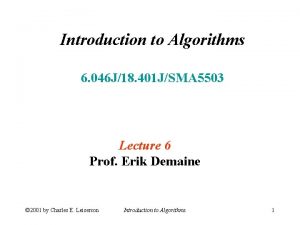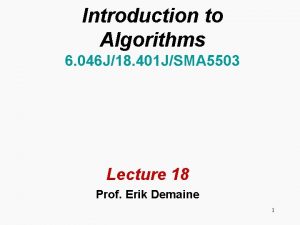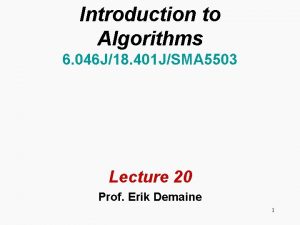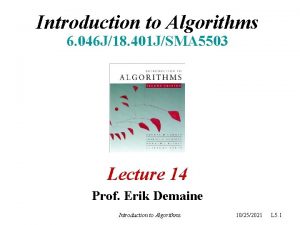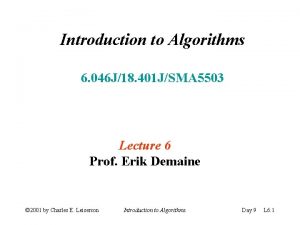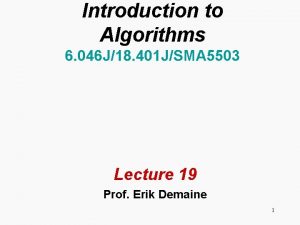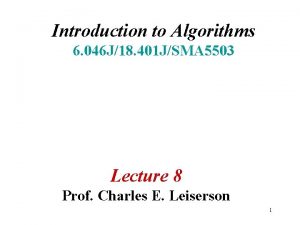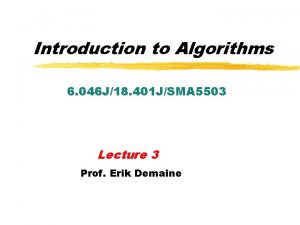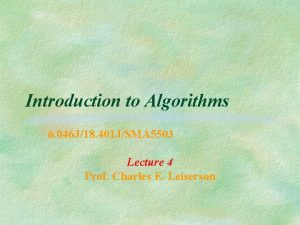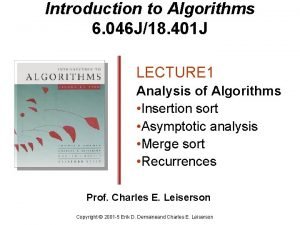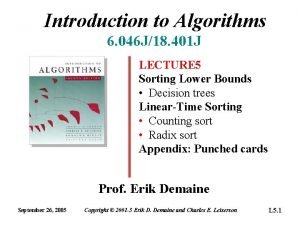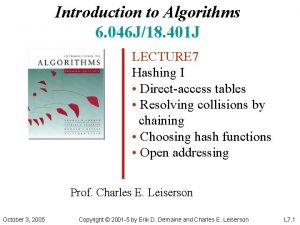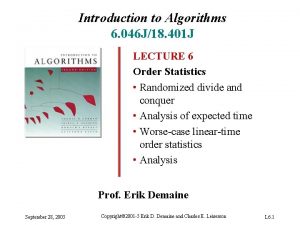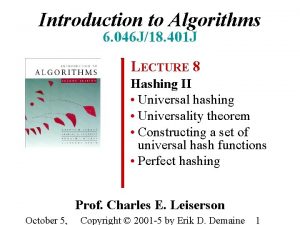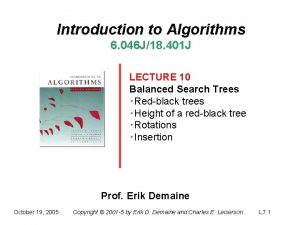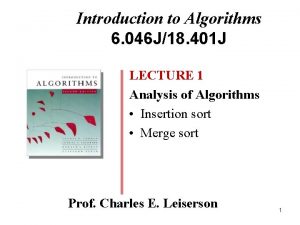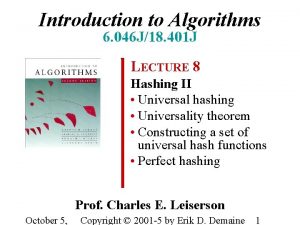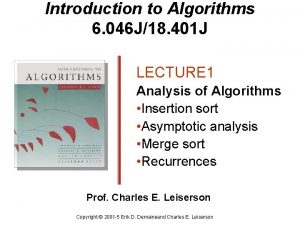Introduction to Algorithms 6 046 J18 401 JSMA












![Hairy recurrence (But not quite as hairy as the quicksort one. ) Prove: E[T(n)] Hairy recurrence (But not quite as hairy as the quicksort one. ) Prove: E[T(n)]](https://slidetodoc.com/presentation_image_h/04e35f77e4064989c2c8e395389b0735/image-13.jpg)

















- Slides: 30

Introduction to Algorithms 6. 046 J/18. 401 J/SMA 5503 Lecture 6 Prof. Erik Demaine © 2001 by Charles E. Leiserson Introduction to Algorithms 1

Order statistics Select the ith smallest of n elements (the element with rank i). • Naive algorithm: Sort and index ith element. Worst-case running time using merge sort or heapsort (not quicksort). © 2001 by Charles E. Leiserson Introduction to Algorithms 2

Randomized divide-and-conquer algorithm © 2001 by Charles E. Leiserson Introduction to Algorithms 3

Example Select the i = 7 th smallest: Partition: Select the 7 – 4 = 3 rd smallest recursively. © 2001 by Charles E. Leiserson Introduction to Algorithms 4

Intuition for analysis (All our analyses today assume that all elements are distinct. ) Lucky: Unlucky: arithmetic series Worse than sorting! © 2001 by Charles E. Leiserson Introduction to Algorithms 5

Analysis of expected time The analysis follows that of randomized quicksort, but it’s a little different. Let T(n) = the random variable for the running time of RAND-SELECT on an input of size n, assuming random numbers are independent. For k = 0, 1, …, n– 1, define the indicator random variable if PARTITION generates a k : n–k– 1 split, otherwise. © 2001 by Charles E. Leiserson Introduction to Algorithms 6

Analysis (continued) To obtain an upper bound, assume that the ith element always falls in the larger side of the partition: © 2001 by Charles E. Leiserson Introduction to Algorithms 7

Calculating expectation Take expectations of both sides. © 2001 by Charles E. Leiserson Introduction to Algorithms 8

Calculating expectation Linearity of expectation. © 2001 by Charles E. Leiserson Introduction to Algorithms 9

Calculating expectation Independence of choices. © 2001 by Charles E. Leiserson from other random Introduction to Algorithms 10

Calculating expectation Linearity of expectation; © 2001 by Charles E. Leiserson Introduction to Algorithms 11

Calculating expectation Upper terms appear twice. © 2001 by Charles E. Leiserson Introduction to Algorithms 12
![Hairy recurrence But not quite as hairy as the quicksort one Prove ETn Hairy recurrence (But not quite as hairy as the quicksort one. ) Prove: E[T(n)]](https://slidetodoc.com/presentation_image_h/04e35f77e4064989c2c8e395389b0735/image-13.jpg)
Hairy recurrence (But not quite as hairy as the quicksort one. ) Prove: E[T(n)] ≤ cn for constant c > 0. • The constant c can be chosen large enough so that E[T(n)] ≤ cn for the base cases. © 2001 by Charles E. Leiserson Introduction to Algorithms 13

Substitution method Substitute inductive hypothesis. © 2001 by Charles E. Leiserson Introduction to Algorithms 14

Substitution method Use fact. © 2001 by Charles E. Leiserson Introduction to Algorithms 15

Substitution method Express as desired – residual. © 2001 by Charles E. Leiserson Introduction to Algorithms 16

Substitution method if c is chosen large enough so that cn/4 dominates the © 2001 by Charles E. Leiserson Introduction to Algorithms 17

Summary of randomized order-statistic selection • Works fast: linear expected time. • Excellent algorithm in practice. • But, the worst case is very bad: Is there an algorithm that runs in linear time in the worst case? . Yes, due to Blum, Floyd, Pratt, Rivest, and Tarjan [1973]. IDEA: Generate a good pivot recursively. © 2001 by Charles E. Leiserson Introduction to Algorithms 18

Worst-case linear-time order statistics 1. Divide the n elements into groups of 5. Find the median of each 5 -element group by rote. 2. Recursively SELECT the median x of the �n/5�� group medians to be the pivot. 3. Partition around the pivot x. Let k = rank(x). 4. if i = k then return x elseif i < k then recursively SELECT the ith smallest element in the lower part else recursively SELECT the (i–k)th smallest element in the upper part © 2001 by Charles E. Leiserson Introduction to Algorithms 19

Choosing the pivot © 2001 by Charles E. Leiserson Introduction to Algorithms 20

Choosing the pivot 1. Divide the n elements into groups of 5. © 2001 by Charles E. Leiserson Introduction to Algorithms 21

Choosing the pivot 1. Divide the n elements into groups of 5. Find the median of each 5 -element group by rote. © 2001 by Charles E. Leiserson Introduction to Algorithms 22

Choosing the pivot 1. Divide the n elements into groups of 5. Find the median of each 5 -element group by rote. 2. Recursively SELECT the median x of the� n/5� � group medians to be the pivot. © 2001 by Charles E. Leiserson Introduction to Algorithms 23

Analysis At least half the group medians are ≤ x, which is at least ��n/5�/2�= �n/10�group medians. © 2001 by Charles E. Leiserson Introduction to Algorithms 24

Analysis (Assume all elements are distinct. ) At least half the group medians are ≤ x, which is at least �� n/5�/2� �=�n/10�group medians. • Therefore, at least 3�n/10�elements are ≤ x. © 2001 by Charles E. Leiserson Introduction to Algorithms 25

Analysis (Assume all elements are distinct. ) At least half the group medians are ≤ x, which is at least ��n/5 �/2�= �n/10�group medians. • Therefore, at least 3�n/10� elements are ≤ x. • Similarly, at least 3�n/10� elements are ≥ x. © 2001 by Charles E. Leiserson Introduction to Algorithms 26

Minor simplification • For n ≥ 50, we have 3 �n/10 �≥ n/4. • Therefore, for n ≥ 50 the recursive call to SELECT in Step 4 is executed recursively on ≤ 3 n/4 elements. • Thus, the recurrence for running time can assume that Step 4 takes time T(3 n/4) in the worst case. • For n < 50, we know that the worst-case time is T(n) = Θ(1). © 2001 by Charles E. Leiserson Introduction to Algorithms 27

Developing the recurrence SELECT(i, n) 1. Divide the n elements into groups of 5. Find the median of each 5 -element group by rote. 2. Recursively SELECT the median x of the �n/5 � �group medians to be the pivot. 3. Partition around the pivot x. Let k = rank(x). 4. if i = k then return x elseif i < k then recursively SELECT the ith smallest element in the lower part else recursively SELECT the (i–k)th smallest element in the upper part © 2001 by Charles E. Leiserson Introduction to Algorithms 28

Solving the recurrence if c is chosen large enough to handle both the Θ(n) and the initial conditions. © 2001 by Charles E. Leiserson Introduction to Algorithms 29

Conclusions • Since the work at each level of recursion is a constant fraction (19/20) smaller, the work per level is a geometric series dominated by the linear work at the root. • In practice, this algorithm runs slowly, because the constant in front of n is large. • The randomized algorithm is far more practical. Exercise: Why not divide into groups of 3? © 2001 by Charles E. Leiserson Introduction to Algorithms 30
 S/2005 j18
S/2005 j18 046 suunta
046 suunta Láncfűrész vágási formák
Láncfűrész vágási formák Algorithm analysis examples
Algorithm analysis examples Bioinformatics
Bioinformatics Design and analysis of algorithms introduction
Design and analysis of algorithms introduction Introduction to algorithms
Introduction to algorithms Introduction to algorithms slides
Introduction to algorithms slides Introduction to algorithms 2nd ed
Introduction to algorithms 2nd ed Introduction to algorithms
Introduction to algorithms Introduction to algorithms lecture notes
Introduction to algorithms lecture notes Introduction to the design and analysis of algorithms
Introduction to the design and analysis of algorithms Introduction to sorting algorithms
Introduction to sorting algorithms Introduction to algorithms 2nd edition
Introduction to algorithms 2nd edition Introduction to algorithms 2nd edition
Introduction to algorithms 2nd edition Introduction to bioinformatics algorithms
Introduction to bioinformatics algorithms Bioinformatics
Bioinformatics Lsp 401
Lsp 401 Svartpilen 401 dyno
Svartpilen 401 dyno Cse 401
Cse 401 Ge 401
Ge 401 Food code 3-401 be displayed texas
Food code 3-401 be displayed texas Eng m 401
Eng m 401 Clase 401
Clase 401 401 branard street houston tx
401 branard street houston tx Bmb 401 umiami
Bmb 401 umiami Comm 401
Comm 401 401 relevance
401 relevance Hinário adventista 401
Hinário adventista 401 Hd-wp-4k-401-c
Hd-wp-4k-401-c Quantas prendas a turma 403 já levou para a escola
Quantas prendas a turma 403 já levou para a escola
